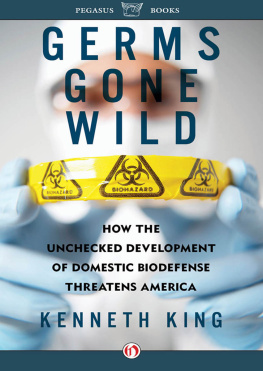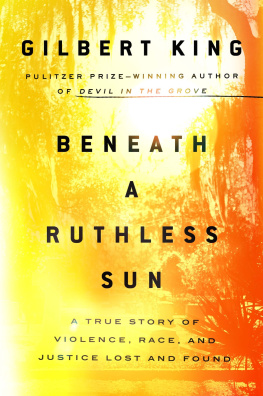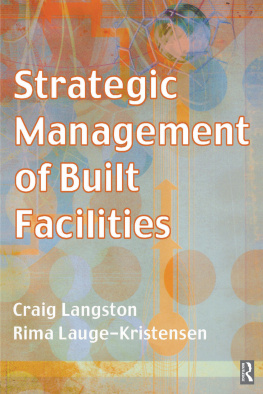
HOW THE
UNCHECKED DEVELOPMENT
OF DOMESTIC BIODEFENSE
THREATENS AMERICA
KENNETH KING

PEGASUS BOOKS
NEW YORK
This book is dedicated to the memories of:
My wife of 29 years, Betty Segars King
My father, Elwood S. King
My mentor, James Baker Hall
______
The publisher fondly dedicates this volume to the talented Maria Fernandez and Phil Gaskill, without whom this book would not have been possible.
Contents
CHAPTER ONE
A Biodefense Juggernaut
An Invasion, and the Resistance
On April 23, 2007, Americas war on terror sent emissaries to a rural pasture in south central Kentucky. They arrived by military helicopter and a van and car convoy escorted by sheriffs deputies and state police. The convoy passed a cluster of protesters holding signs such as Hal No! No Bio-Lab! and The Chamber of Commerce Is Not the Community.
Nearly six thousand people from this heavily Republican, largely rural district had signed petitions asking the Department of Homeland Security (DHS) not to bring the countrys second biggest biodefense facility to this particular plot of land, despite the fact that their congressman, county judge, mayor, city council, fiscal court, Chamber of Commerce, and local newspaper had spoken on their behalf and told DHS what a perfect spot this would be for a $550 million biobonanza.
Like people in other rural communities alarmed by NBAF (the National Bio and Agro-Defense Facility), they had been told by the local influentsia that they were backward and ignorant for worrying about this Homeland Security-controlled facility and its Pandoric tinkerings with a yet-to-be-specified list of incurable pathogens. It would be as safe as going to Wal-Mart, their congressman said. It would be state of the art. It would be a quantum leap.
Despite those exhortations, 2800 people had signed petitions opposing the facility during two weeks in March 2006. Another 2000 people had signed during the next two months. The rest had trickled in afterward, without any major efforts to sustain the initial drive. In the meantime, opponents had held two major rallies, established a Web site with Fact Sheets and a video, appeared on radio and television, and written a slew of letters and op-eds to local and state newspapers.
Now, over a hundred of them had gathered, on short notice, to confront the Homeland Security inspectors as they tried to slip quietly into the county and out. Channel 36, a Lexington television station, filmed the protesters, the stone-faced passage of the official convoy, and the setdown of the military chopper. After the convoy had passed, the protesters followed them part of the way back, stopping at the boundary of the proposed lab site.
For thirty minutes or so, as the inspectors assessed the biotech potential of Kentucky pasture, the protesters chanted slogans: No Bio Lab! No Fort Detrick! No Plum Island! Some people shouted more spontaneous comments: Wheres Hal Rogers? (Rogers was the U.S. Representative chiefly responsible for DHSs interest in Kentucky). Look at this beautiful country! You ought to be ashamed of yourselves! This is our home! You go back to yours! A large state trooper loomed near the boundary line, screening the protesters from the entourage of inspectors and inspector-handlers. That evening, Channel 36 spliced together a two-minute newscast. Prominent in the newscast was the military helicopter, dropping out of the sky like a predatory bird, like the shock troops for an armed invasion.
Biodefense Shucking and Jiving
I had worked feverishly the week before, trying to help plan the protest, writing press releases and a speech, and sending E-mails to people who had signed online petitions. Four months earlier, my wife of 29 years had died suddenly, less than a year after our divorce. My mother had torn her knee ligaments at almost the same time, and in the summer following the protest, we learned that my father had a rare form of lymphoma. I was not the only local NBAF opponent affected by personal tragedies during this period. Among the small steering group for Citizens Against a Kentucky Biolab, Floyd Lovins lost his longtime friend and employer, Phil Cash of Melody Music, the same week the congressman announced his NBAF efforts. David Taylor would lose his father to cancer a few months later. The local NBAF propaganda effort rolled right along regardless.
By the time that military helicopter descended onto the Pulaski County pasture, the war on terror already had beachheads in our county, thanks to the wheeling and dealing of our congressman, U.S. Representative Harold Hal Rogers. Rogers had chaired the House Appropriations homeland security subcommittee until the November 2006 elections conveyed the position to a Democrat. His achievements in that position illustrate the way homeland security and biodefense have become trendy new pork barrels.
In 2004, Rogers establishedin Pulaski Countythe National Institute for Hometown Security and the Kentucky Homeland Security University Consortium. Both were funded by DHS, the agency funded by Rogerss subcommittee. In a synergistic fashion typical of Rogers, both organizations were housed in an earlier pork barrel project, the Southern Kentucky Rural Development Center. (Rogers had helped build SKRDC with $15.5 million of public money in the 1990s, and the Center now operates with an $18 million annual budget, mostly derived from public funds.) A December 2005 Washington Post article noted that the Institute and Consortium had received, in the first year of their existence, $34 million in combined grants from DHSs science and technology directorate, far outstripping the biodefense proceeds of better-known consortia at Texas A&M, Johns Hopkins, Minnesota, Southern Cal, and Maryland.
Few would have considered Pulaski County a central battleground in the war on terror, but former Homeland Security Director Ridge said DHS funded the National Institute for Hometown Security under the unique notion that the homeland is not secure until the hometown is secure. Apparently standard Washington lobbyist come-ons werent intimate enough for SAIC.
Once the congressman had established his Homeland Security beachheads, however, he wanted more. And so he went after NBAF, a proposed human, animal, and zoonotic disease supercenter surpassed in size only by the new biodefense campus at Fort Detrick in Maryland. The new NBAF will be controlled by DHS, and like Detrick, will include Biosafety Level Four (BSL-4) labsstudying diseases for which no vaccine or cure existsas a major component.
NBAF was announced in 2005 as a replacement for an existing offshore facility at Plum Island, New York. Plum Island might not have a BSL-4 rating but it does have a troubled history involving OSHA (Occupational Safety and Health Administration) and EPA (Environmental Protection Agency) safety citations, a critical investigation by the Government Accountability Office (GAO), several foot-andmouth outbreaks, and a three-hour total power loss which zapped the negative air pressure, the most important fail-safe mechanism in high containment labs. Michael Carrolls 2004 bestseller,


















